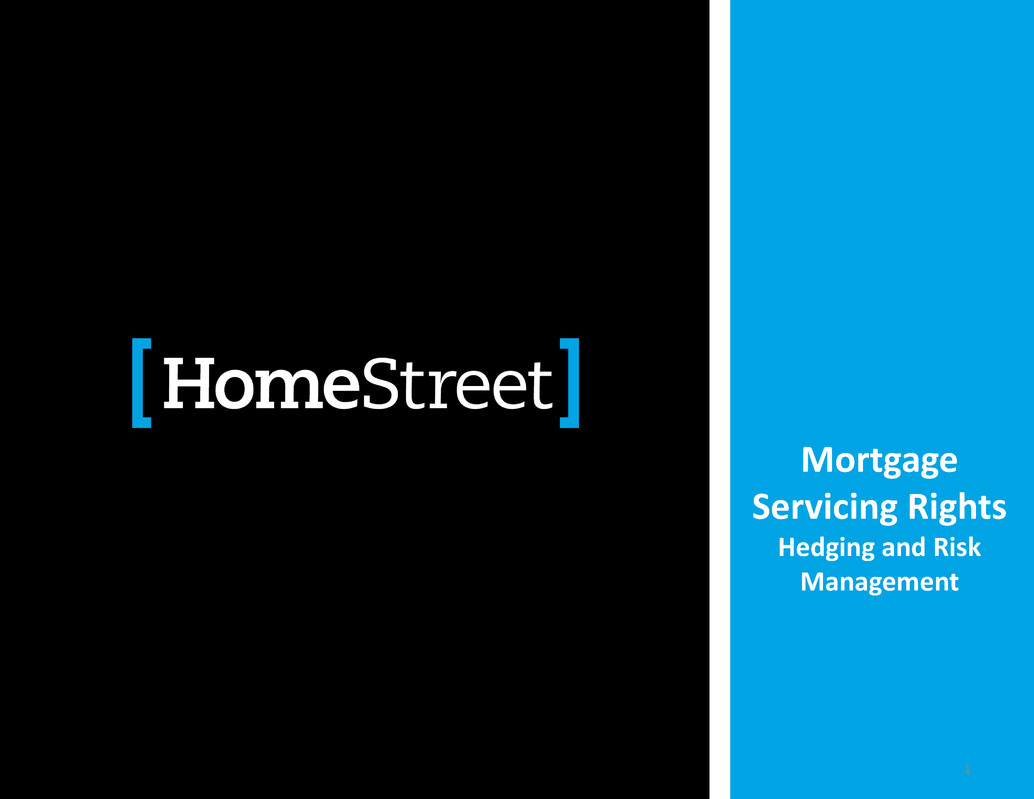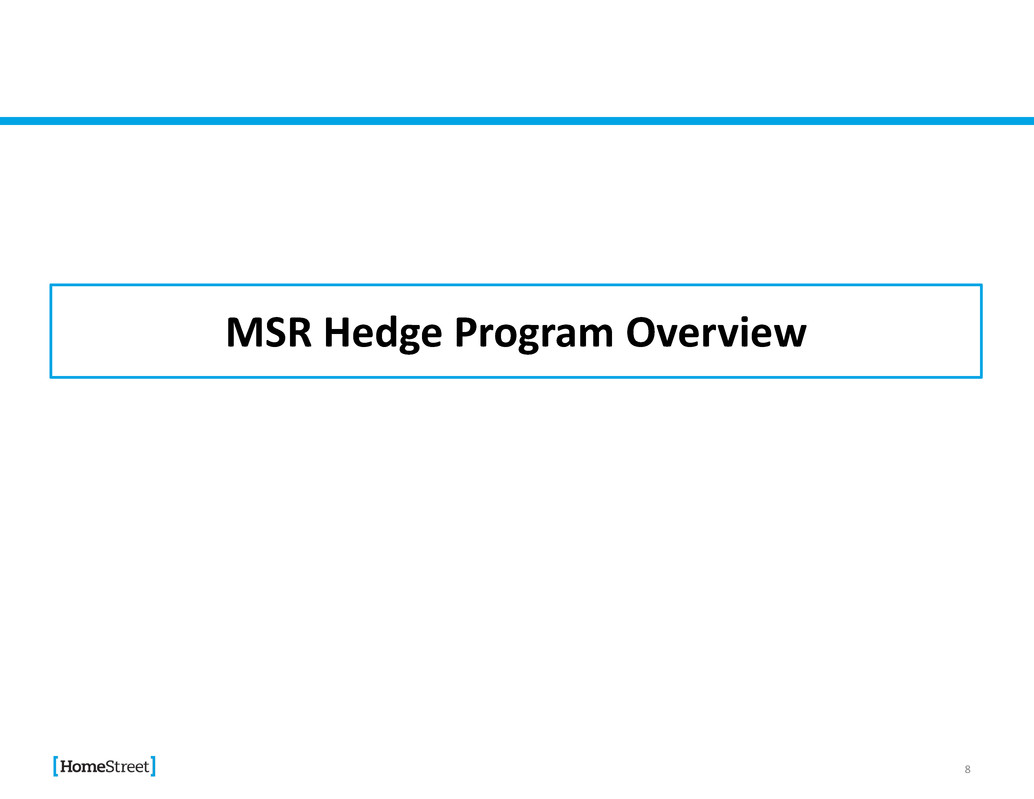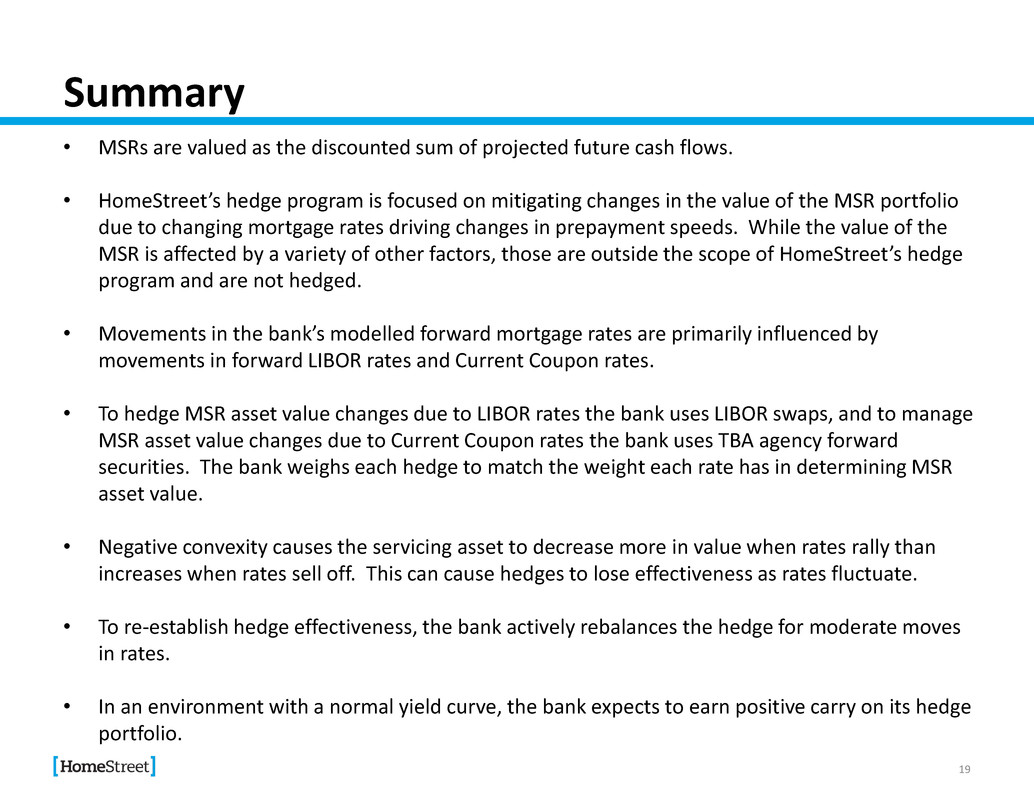Attached files
| file | filename |
|---|---|
| 8-K - FORM 8-K - HomeStreet, Inc. | form8-kmsrhedgingpresentat.htm |

Mortgage Servicing Rights Hedging and Risk Management 1

Objective Provide a primer on the bank’s MSR hedging program, with a focus on both breaking out the drivers of MSR value that are included within the hedging program, and on explaining how the bank hedges value changes in the MSR asset caused by changes in those drivers. 2

Contents • Interest Rates as Drivers Of MSR Asset Value • MSR Hedge Program Overview • Convexity, Basis Risk & Other Hedging Considerations • Summary & Glossary 3

Interest Rates as Drivers of MSR Asset Value 4

Example – Individual MSR Valuation Assuming Conventional 30 Year Loan Annual Amount UPB $100,000 Servicing Cost $60 Note Rate 4.750% Ancillary Fee Income $35 Base Servicing 0.250% Discount Rate 10.00% Excess Servicing 0.140% The fair value of the base and excess servicing of the example loan is $1,422.03. Although the contractual term of the loan is 360 months, the actual term is estimated at 185 months due to expected prepayment. A + B + C - D = E Month Base Excess Ancillary Servicing Net Servicing Servicing Fee Servicing Fee Fee Income Cost Revenue Income Income 1 20.83 11.67 2.92 5.00 31.67 2 20.80 11.65 2.92 5.01 31.62 3 20.77 11.63 3.35 5.02 31.56 . . . . 185 0.02 0.01 4.54 5.67 -1.10 Total 1,981.72 1,109.76 722.81 903.52 2,910.77 Initial MSR - NPV $1,263.79 $707.72 $354.03 $903.52 $1,422.03 Subject to changes in Interest rates 5

6 • Servicing valuation requires estimation of the related loan’s expected life. • This is done through the use of prepayment speed assumptions. Projected prepayment speeds are the largest determinant of MSR asset values. • The largest factor in forecasting prepayment speeds are current and projected mortgage rates. Primary mortgage rates are modelled as a function of secondary mortgage rates. Current secondary mortgage rates are proxied using the Current Coupon , a the calculated par rate for a hypothetical agency security deliverable in 30 days. Forward secondary mortgage rates are forecast primarily using forward LIBOR rates, plus an actuarially derived basis spread of secondary mortgage rates over LIBOR rates. • As mortgage rates rise, projected prepayments decline, increasing the value of MSR assets. As mortgage rates fall, projected prepayments increase, decreasing the value of MSR assets. • In addition to projected mortgage rates, prepayment speeds are also influenced by a variety of factors that are outside the scope of HomeStreet’s hedge program, and are not hedged. These include: Interest Rates as Drivers of MSR Value Loan product Home price appreciation/LTV Loan term Borrower profile Loan age Home geography Loan rate Changes in agency loan programs

MSR Risk Profile To Interest Rates – Unhedged Key Takeaways The value of the MSR asset increases as rates rise primarily due to slower projected prepayments. The value of the MSR asset decreases as rates decline primarily due to faster projected prepayments. MSR Value as a function of rate change -60 -40 -20 - 20 40 60 -200 -150 -100 -50 - 50 100 150 200 Va lue Ch an ge (m m) Rate Shock Higher interest rates = Higher MSR value Lower interest rates = Lower MSR value Prepayments as a function of rate change 0 5 10 15 2 25 -200 -150 -100 -50 - 50 100 150 200 Pr ep ay me nt Sp ee d Rate Shock 7

8 MSR Hedge Program Overview

• The goal of HomeStreet’s MSR hedging program is to offset changes in the value of MSR assets caused by movements in current and projected mortgage rates. • Movements in HomeStreet’s projected mortgage rates are influenced by movements in LIBOR rates and Current Coupon rates. To the extent movements in LIBOR rates and Current Coupon rates diverge, the bank recognizes Basis Risk. Basis Risk is the P&L impact of the fluctuating spread relationship between Current Coupon and Swap rates. • To hedge changes in the value of the MSR asset due to changes in the Current Coupon rate, the bank hedges using TBAs (forwards used to trade pass through securities issued by the GSEs). • To hedge changes in the value of its MSR asset due to LIBOR rates, the bank uses LIBOR swaps. The bank is also examining the use of Eurodollar futures, swap futures and treasury futures to hedge forward LIBOR rate risk while reducing transaction costs. The bank makes limited use of purchased option contracts to protect against large shocks in interest rates. • While ancillary fee income, servicing expenses, and non-interest rate drivers of prepayment speed such as borrower behavior assumptions all effect MSR values, these factors are all outside the scope of the bank’s MSR hedging program and as such are not hedged (the bank is fully exposed to changes in the value of the MSR asset due to changes in these assumptions). MSR Hedging Program – Overview 9

-60 -40 -20 - 20 40 60 -200 -150 -100 -50 - 50 100 150 200 Va lu e C h an ge ( m m ) Rate Shock Asset Hedge Net MSR Hedging Program – Overview Key Takeaways When rates rise, the hedge book loses value. When rates decline, the hedge book gains value. These gains and losses in the hedge book are structured to offset gains and losses in MSR assets. As the magnitude of rate movements increase, the hedge becomes less effective in offsetting changes in the MSR asset value. This is due to the differing convexity profiles of the MSR asset and the hedge book (discussed more in the next section). MSR Value as a function of rate shock (example) Higher interest rates = Higher MSR value & Lower Hedge Value Lower interest rates = Lower MSR value & Higher Hedge Value 10

11 Convexity, Basis Risk & Carry

Managing Convexity 12 • The MSR asset typically exhibits negative convexity. This means the rate at which MSR assets decrease in value accelerates as rates fall and the rate at which the MSR asset increases in value decelerates as rates rise. • While HomeStreet’s hedge instruments typically exhibit positive convexity, the magnitude of that positive convexity is usually smaller than the negative convexity exhibited by the MSR asset. • This difference in convexity profiles means as rates move the duration of the MSR asset will diverge from the duration of the hedge portfolio. • To reduce hedge ineffectiveness caused by the mismatched convexity profiles, the bank monitors and rebalances its hedge position on a daily (and intraday) basis. • The rebalancing is conducted to match, for small movements in interest rates, the rate at which the value of the hedge changes to the rate at which the value of the MSR changes (i.e., to match the durations).

Risk Profile – Negative Convexity (Unhedged) Key Takeaways • The dotted line depicts a change in value for a bond with no convexity while the solid line represents the change in value of the MSR asset. • When rates rise, the value of the MSR asset increases but less than expected as the asset becomes less sensitive to rates. • When rates decrease, the value of the MSR asset drops more than expected as the asset becomes more rate sensitive. • Negative convexity means that the value of the servicing asset decreases more when rates rally than it increases when rates sell off. MSR Value ($) as a function of rate shock (example) -100 -50 - 50 100 -200 -150 -100 -50 - 50 100 150 200 Ch an ge in Va lue (m m) Rate Shock No convexity Negative Convexity 13 (in $000s) MSR Value Change Rates Unchanged 110,533 25 bp Decline in rates 97,540 -12,993 25 bp Increase in rates 117,561 7,029 Example of MSR Value Change

Risk Profile – Negative Convexity (Hedged) Key Takeaways • While the hedge offsets the majority of the changes in MSR asset value from interest rate volatility, the negative convexity in the MSR asset causes the hedge to lose effectiveness as interest rates move. • By rebalancing hedges as rates move, HomeStreet can reduce the effects of the MSR’s negative convexity by matching the rate at which both the hedge and the MSR asset value changes for a small move in interest rates. MSR Value ($) as a function of rate shock (example) 14 -100 -80 -60 -40 -20 - 20 40 60 80 100 -200 -150 -100 -50 - 50 100 150 200 C h an ge in Valu e ( m m ) Rate Shock Hedges MSR Net Net Value – Zoomed View (Example) -0.50 -0.40 -0.30 -0.20 -0.10 - 0.10 0.20 0.30 0.40 0.50 -25 -20 -15 -10 -5 - 5 10 15 20 25 C h an ge in Valu e ( m m ) Rate Shock Net

Basis Hedging 15 • Basis Risk refers to the P&L impact of changes to the spread relationship between Current Coupon rates, used to estimate current and near-term mortgage rates, and swap rates, used to forecast long-term mortgage rates. • HomeStreet mitigates Basis Risk utilizing both LIBOR swaps and TBA agency securities.

Basis Hedging 16 Take-Away: The value of HomeStreet’s portfolio of MSR assets is affected by both changes in Current Coupon rates and changes in LIBOR swap rates. HomeStreet hedges each of these components, weighting the hedges to match the change in the value of the hedge to the change in the value of the MSR portfolio. Because the value of the specific TBAs that HomeStreet uses to hedge Current Coupon rates may not correlated 1-for-1 with movements in Current Coupon rates, TBA hedges reduce but do not eliminate basis risk. Basis Risk Example: LIBOR swap rates fall by 1 basis point, Current Coupon rates rise by 1 basis point. Basis MSR Assets Swaps TBA's Explanation of Impact Current Coupon Rates Rise 1 basis point Value Increases No Change Value Decreases The increase in the value of the MSR Asset caused by Current Coupon rate changes is mitigated by the decrease in the value of the TBA Hedges. Swap Rates Fall 1 basis point Value Decreases Value Increases No Change The decrease in the value of the MSR Asset caused by LIBOR rate changes is mitigated by the increase in the value of the Swap Hedges. Net Effect Widens by 2 bps Value Decreases (MSR Asset is 6x-7x more exposed to LIBOR Rate moves than Current Coupon rate moves). The increase in the value of the MSR Asset caused by Current Coupon rate moves is mitigated by the decrease in the value of the TBA hedge book. The decrease in the value of the MSR asset caused by Swap rate moves is mitigated by the increase in the value of the Swap hedge book. Value increases (DV01 on the Swaps hedge is 6x-7x larger than the DV01 on the TBA hedge).

Yield on MSR Hedge Instruments and Other Hedging Considerations 17 Yield on MSR Hedge Instruments • To mitigate the exposure of the bank’s MSR portfolio to falling interest rates, HomeStreet enters into long interest rate hedge positions (e.g., HomeStreet agrees to receive fixed rate payments, and so benefits when rates fall). • The return HomeStreet earns from holding these received fix positions that is attributable solely to the passage of time is referred to as “carry.” Other Hedging Considerations Outside the Scope of HomeStreet’s Hedge Program • The value of HomeStreet’s MSR portfolio also fluctuates due to changes in model inputs and/or assumptions that are outside the scope of the bank’s hedging program. These factors may include, but are not limited to: Tuning MSR valuation model prepayment speeds to better align modelled prepayment assumptions with observed borrower prepayment behavior. Changes to the model to better align model behavior with observed market best practices. Changes in un-hedgeable market variables which drive projected prepayments, such as changes in the Housing Price Index. • Changes in these model inputs and/or assumptions are outside the scope of HomeStreet’s hedge program and so may drive volatility in the bank’s risk management results.

18 Summary and Glossary

Summary • MSRs are valued as the discounted sum of projected future cash flows. • HomeStreet’s hedge program is focused on mitigating changes in the value of the MSR portfolio due to changing mortgage rates driving changes in prepayment speeds. While the value of the MSR is affected by a variety of other factors, those are outside the scope of HomeStreet’s hedge program and are not hedged. • Movements in the bank’s modelled forward mortgage rates are primarily influenced by movements in forward LIBOR rates and Current Coupon rates. • To hedge MSR asset value changes due to LIBOR rates the bank uses LIBOR swaps, and to manage MSR asset value changes due to Current Coupon rates the bank uses TBA agency forward securities. The bank weighs each hedge to match the weight each rate has in determining MSR asset value. • Negative convexity causes the servicing asset to decrease more in value when rates rally than increases when rates sell off. This can cause hedges to lose effectiveness as rates fluctuate. • To re-establish hedge effectiveness, the bank actively rebalances the hedge for moderate moves in rates. • In an environment with a normal yield curve, the bank expects to earn positive carry on its hedge portfolio. 19

Glossary • Ancillary Income: Includes late fees, payoff statement fees, or other administrative fees related providing information to the borrower. • Base Servicing Fees: Compensation received by the servicer to ensure payments for principal, interest, taxes, and insurance are received and remitted to the appropriate parties. The fee is typically 25 bps for loans securitized with FNMA and FHLMC and 44 bps for loans securitized with GNMA. • Basis: The difference between the rates used to calculate the value of the MSR Hedge Book, and the rates used to value the MSR asset. • Basis Risk: The P&L impact of the fluctuating spread relationship between the Current Coupon and spot swap rates. • Convexity: The rate at which duration changes as interest rates move. • Current Coupon: The calculated yield on a hypothetical par agency mortgage security 30 days forward. Usually calculated from the TBA agency securities trading on either side of par. • DV01: The change in value of a position given a one basis point parallel shift lower in interest rates. • Duration: An approximate percentage change in price for a 100 basis point parallel shift in the yield curve. • Excess Servicing Fees: Additional compensation received after payment of agency guarantee fees, base servicing fees, and MBS coupon interest. • Float Income: Interest earned from the day the payment is received from the borrower to the day it is remitted to the investor. • Hedge Book: HomeStreet’s swap and TBA positions designed to hedge HomeStreet’s MSR portfolio. • P&I Advances: Interest on the amount the servicer must advance if a monthly payment is not made on time by the borrower. • Servicing Cost: Marginal cost of payment processing, payment remittance, investor reporting, default management and customer service. 20
